
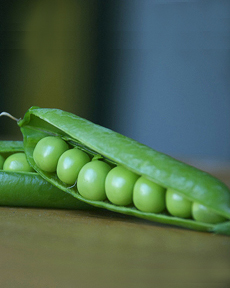 Pea pods. Photo by Gentian Lee | Wikimedia. Pea pods. Photo by Gentian Lee | Wikimedia.
June 2005
Last Updated November 2024
|
 |
All Types Of Grains & Beans
Page 5: Terms With M ~ P
All types of grains; here, terms including polenta plus navy, pinto, pigeon, and red beans. If you’d like to suggest additional words, use the Contact Us link on this page. See our many other food glossaries.
Click on a letter to go to the appropriate glossary section:
a b c d e f g h i j k l m n o p q r s t u v w x y z
This material is copyrighted and cannot be reproduced in whole or in part
without written permission. You are welcome to link to it.
MANIOC
See cassava.
MASOOR DAL or ORANGE/SPLIT RED LENTILS or ULUNDHU
Lentils originated in southwestern Asia along the Indus River, and have been eaten for more than 8,000 years. They are a staple food for many South Asian cultures. Split red lentils have a delicate, nutty taste and are commonly used in India to make spicy dals. They cook very quickly and are easy to digest. In the West, these lentils are used in soups, stews, bakes, and sauces for pasta and salads.
|
|
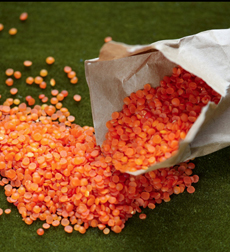
Red lentils. Photo courtesy Malaysian Kitchen. |
MILLET
Likely indigenous to tropical western Africa, millet is grown in many parts of the third world: It has a short growing season under dry, hot conditions. Pearl millet is a staple food crop in Africa, India, and Southeast Asia. Varies varieties of millet have been cultivated in East Asia for at least 10,000 years. Here’s more about millet, plus recipes.
|
|
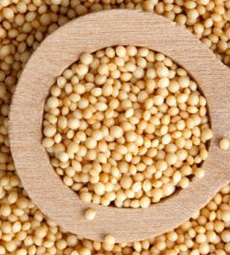
Millet. Photo courtesy Bob’s Red Mill. |
MOONG DAL or DHULI MOONG or YELLOW LENTILS WITHOUT SKIN or PAYATHAM PARUPPU
These are whole yellow lentils (moong) that are split and hulled. Native to India, they are tiny cylindrical seeds, easy to cook and digest (in Ayurveda, split moong dal is recommended for children, elderly people, and convalescents as it is easily digested). The whole moong beans and split ones are quite different and seldom interchangeable. Their preparation is similar to masoor dal, the split red lentils.
NAVY BEAN or YANKEE BEAN
The navy bean (Phaseolus vulgaris) is a pea-sized, off-white, oval bean, about 3/8-inch long. It is so-named because it has been a staple food for the U.S. Navy since the mid-1800s in soups, pork and beans, and other bean dishes (it absorbs flavor easily, so it works well in soups). It is related to the kidney bean and is the most widely known bean in the white bean family. Navy beans have a mild flavor and mealy texture.
|
|

Navy beans are available at Amazon.com. |
PEA
Peas (photo at top of page) are a member of the legume family, the seed or seed-pod of the legume Pisum sativum. Each pod contains several peas. It is botanically a fruit because the seeds are contained inside the pod, although like other savory fruits (cucumbers, tomatoes, zucchini) it is treated like a vegetable in food preparation. There are many varieties of peas, including cowpeas, pigeon peas, snow peas, and snap peas, which are available fresh, frozen, or canned; peas are also grown to produce dry peas like the split pea.
|
|
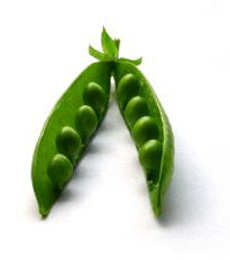
Fresh peas. Photo by Marta Rostek | SXC. |
PIGEON PEA
The Pigeon pea (Cajanus indicus) is a bean native to Africa that is now widely used in Caribbean and Southern American cooking. These small beans grow in a long, twisted, fuzzy pod. They are about 1/4 inch round and have a beige color with light brown speckles; the color fades with cooking (heat). The flavor is pungent, the texture is mealy texture. They are also known as caja pea, Congo pea, gandule, goongoo pea, and toor dal.
|
|
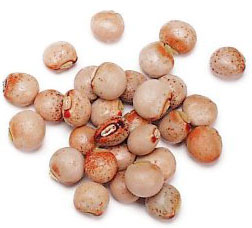
Pigeon peas are available at Amazon.com. |
PINTO BEAN
An oval, beige-colored bean distinguished by its tan splotched surface. It is popular in Mexican dishes including chili, refried beans, rice and beans, soups, and stews.
|
|
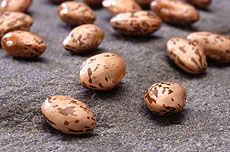
Photo of pinto beans by Scott Bauer, U.S. Agricultural Research Service. |
POLENTA or CORN GRITS
Polenta is simply coarsely ground corn, also known as cornmeal, that is cooked with stock or water. It is known in America as cornmeal mush. See also grits.
|
|
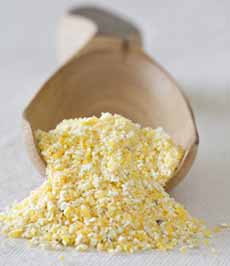
|
| |
|
Polenta is available in supermarkets, Latin American markets, and on Amazon.com. |
|
|
|
POPCORN
The variety of flint corn called popcorn (Zea mays everta) was discovered and bred thousands of years ago when uncooked corn kernels were accidentally dropped by the fire. The popping is due to the amount of moisture within the kernels, 14%–20%, which turns to steam as the kernel is heated. Pressure from the steam builds until the hull ruptures and the kernel forcefully expands 20 to 50 times its original size.
Popcorn, a type of flint corn, is one of six major types of corn, which include dent corn, flint corn, pod corn, flour corn, and sweet corn.
|
|
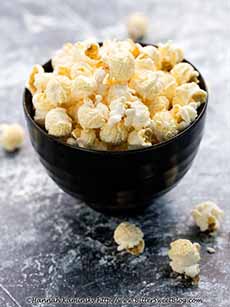
The first popcorn popped “by accident” (photo © Hannah Kaminsky | Bittersweet Blog). |
PULSE
See legume.
Continue To The Next Page: Terms With Q ~ R
Go To The Article Index Above

|












